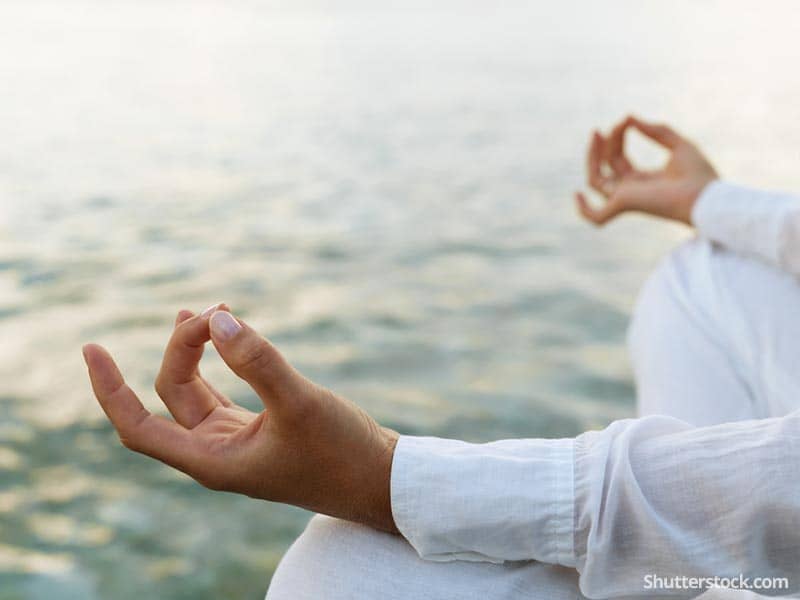If you think back to the last time you sat down to meditate or contemplate something, chances are you were only able to concentrate for a few moments before you were lost in thought. Even when we center our attention on the feeling of the breath or some other object of concentration, within just a few moments the mind jumps up and is off into the future, elaborating an entire scenario. As Mark Twain said, "some of the worst things in my life never happened." Or we get stuck in regret about the past, and our minds leaping into judgment and speculation.
 | ||
| You can feel how much energy is dispersed when the mind is off and running. | ||
 |
If you remember that state, you can feel how much energy is dispersed when the mind is off and running. When we're concentrating, however, all that energy is sheperded back into ourselves. The irony is that it's our own energy we're normally wasting, and it's we who waste it. Concentration helps us reclaim it. Different schools of meditation place different emphasis on the importance of concentration, but all agree that some amount is crucial to both empower the mind and develop that quality of unification or wholeness.
In meditation, concentration may be somewhat different than what we normally think of as developing concentration, like focusing tensely on something. Say we're sitting in meditation and trying to place our awareness on the in-and-out breath, or phrases of lovingkindness, and we think, "If I get a death-grip on this object, then I can concentrate more. But what happens in that situation is we actually concentrate less. Too much tightness hinders concentration.
When I first started practicing meditation, I thought that if I grabbed on to the breath tightly enough, really focused on it, then I could keep my mind from wandering. But of course, my mind wandered all the time. I remember a funny story about the first time I ever met Joseph Goldstein, the co-founder of the Insight Mediation Society and my longtime friend. It was in Bodh Gaya, India, the place of the Buddha's enlightenment, and I was there for my first 10-day meditation retreat.
By the third day, I was so completely frustrated with my inability to tightly control my mind and keep it fastened to the object of concentration that I said to myself, "the next time my concentration wanders, I'm going to bang my head on the wall." But the bell rang, and it was time for lunch. I was listening to two people in the lunch line talking and one asked the other how his morning had been. He answered that he couldn't concentrate strongly, but the afternoon would be better, that it was another beginning. I couldn't believe my ears. I thought, "Why doesn't this guy understand meditation?"
The difference between us was that Joseph had been there for four years, and I'd been there for four days! He had a real understanding of how concentration happens. As our practice evolves, what is needed is something very far from that tormented self-struggle I was engaged in and, instead, a willingness to let go and start again. One of the things I love about meditation practice is that lessons come in small packets, like "let go, begin again," but they have huge implications. It sounds like no big deal, but it reverberates through your life.
There are forms of "wrong concentration," which usually depend on the motivation with which we're practicing. There's a danger of getting hooked on concentration's side effects, and some people practice for the hit of it. As the mind unifies, it can become a vehicle for extraordinary altered states of consciousness. If you get attached to that, then you're lost in the same cycle of grasping and attachment that takes place when your mind is jumping all over the place.
In the Buddhist tradition, we're also taught that concentration needs to be balanced with energy. When Joseph, Jack Kornfield (a Buddhist teacher, author, and co-founder of the Insight Meditation Society), and I first went to Barre, Mass., 25 years ago to look at a possible site for a retreat center, we visited the town square.
 | ||
| A cat can be extremely concentrated at a mouse hole. But from a Buddhist point of view, that's not very skillful. | ||
 |
It was a classic New England scene, with a town green and a statue of the founding father in the center. The Barre town motto was inscribed on the statue, and it read, "Tranquil and Alert." Well, we thought, any town that has a motto like that should have a meditation center! It's the perfect description of that balance. You can get very tranquil and be sluggish, but in meditative concentration, you are tranquil and get alert.
A good way to begin cultivating concentration is to choose an object like the breath, or phrases of lovingkindness, or a sacred word or image. Developing concentration is learning how to connect in the moment with that object and repeatedly letting go of distractions to begin again gently. An image I found helpful in my own practice was the notion of holding something very precious in my hand that if I grabbed too tightly would shatter, and that if I held too loosely would fall and break. The correct relationship would be to cherish it and stay connected to it. As we practice, breath by breath, moment by moment, the mind will go off and do its thing. It'll be scattered or restless, and we have to gently let go and come back to cherish the object of concentration a million times. That's the training of the mind.

